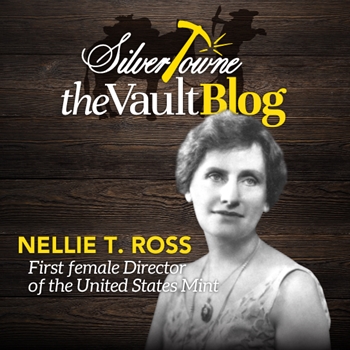
While we are nearing the end of the month of March, which also happens to be Women’s History Month, we would like to take a moment to discuss one of the hundreds of women that are important and that have made a significant impact on the numismatic hobby. Not only did this woman serve as the first woman who headed the United States Mint as a Director, but she was also the first woman in the United States to serve as a governor of a state.
Nellie Tayloe Ross - Early Life
Nellie Tayloe Ross was born in St. Joseph, Missouri, on November 29, 1876, as one of six children. As a young girl, her family relocated to Miltonvale, Kansas. After graduating high school, Ross and her family moved to Omaha, Nebraska, where she taught piano lessons and attended college to become a teacher. After that, she taught kindergarten for four years before meeting her husband in 1900, William Bradford Ross. She would later marry William, a practicer of law, in 1902. They would move to Cheyenne, Wyoming, for William’s career as he would become a leader among the Democratic party.
Governor of Wyoming
William Ross, Nellie’s husband, ran for governor in 1922 and won in a tight race. They both moved into the governor’s mansion and began putting his progressive ideas into action. As the first lady of Wyoming, Nellie was consulted daily and was deeply involved in the social and political life that came with being the governor’s wife. Sadly, just a year and a half into his run as Governor of Wyoming, William died in October of 1924. The Democratic party then nominated Nellie to succeed her husband in a special election where she eventually became the first woman to hold the office of governor of a state in the history of the United States.
As the governor, she continued to put in place her husband’s policies, which included tax cuts, government assistance for farmers, putting amendments in place against child labor, and more. Like her husband, she was also very much for strengthening prohibition laws. Ross ran again for re-election in 1926 but was defeated. She remained active within the Democratic party and eventually became the vice-chairman of the Democratic National Committee and the director of the DNC Women’s Division.
Director of the United States Mint - 1933-1953
Appointed by President Franklin D. Roosevelt, Nellie served a total of 20 years as the first woman Mint Director as she served five different Secretaries of the Treasury including Willian Woodin, Henry Morgenthau, Jr., Fred Vinson, John Snyder, and George Humphrey. Her term spanned the Great Depression, World War II, and the Korean War.
With the increase in business in the 1930s at the end of the Depression increased demand with the addition of the United States entering World War II, the Mint found themselves operating 24 hours a day, seven days a week. Nellie led the charge at hiring hundreds of new employees and the total number increased to 4,000. This was the largest number of individuals working at the Mint at one time. This also led to the construction of three new Mint facilities where she would have her name on the cornerstone of three government buildings. Those buildings included the Mint at San Francisco in 1937, the silver depository at West Point in New York in 1938, and the gold depository at Fort Knox in Kentucky in 1936.
Ross also expanded the program of proof coins in 1936 and later restored the production of proof coins in 1950 after the manufacturing of them had been halted by the war. She was a part of the production of zinc-coated steel pennies and five-cent pieces with reduced copper, nickel and manganese during war efforts to save vital metals as well. The popular Jefferson nickel from 1938 and the Roosevelt dime from 1946 were both designed, engraved, produced, and released during her 20-year tenure. The medal department at the Mint was also increasingly expanded during her administration to accommodate the production of millions of military combat awards and decorations that honored those in the American military that served in World War II.
Later Years
Nellie Ross retired in 1953 from her stint at the Mint and was succeeded by William H. Brett who was appointed by President Dwight D. Eisenhower in 1954. Her remaining lifetime consisted of contributing articles to a number of women’s magazines and travel. She died in Washington, D.C. at the age of 101.







